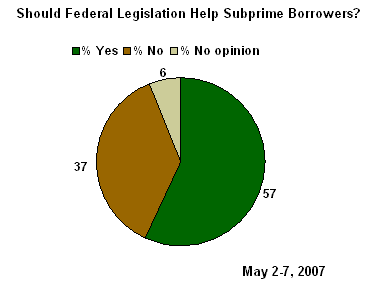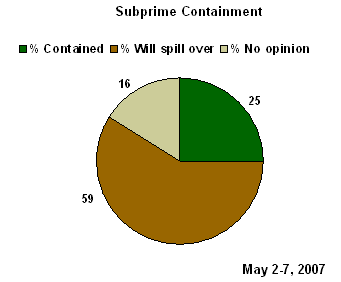GALLUP NEWS SERVICE
PRINCETON, NJ -- In a speech last week before the Federal Reserve Bank of Chicago's 43rd Annual Conference on Bank Structure and Competition, Fed Chairman Ben Bernanke addressed the topic of the subprime mortgage market and its potential impact on the residential real estate market. He noted that, "we are likely to see further increases in delinquencies and foreclosures this year and next …" But, then went on to say, "… given the fundamental factors in place that should support the demand for housing, we believe the effect of the troubles in the subprime sector on the broader housing market will likely be limited, and we do not expect significant spillovers from the subprime market to the rest of the economy or to the financial system."
In sharp contrast, a new May Experian/Gallup Personal Credit Index (PCI) poll shows that a majority of Americans do not share the Fed Chairman's optimism that the subprime mortgage market meltdown will be contained. The new poll also reveals that most Americans feel the ready availability of subprime loans is a bad thing for borrowers while a majority also supports the passing of federal legislation to help subprime borrowers keep their homes and avoid foreclosure.
The Ready Availability of Subprime Loans
Subprime mortgage loans are those made to borrowers who have had credit problems in the past or are otherwise perceived to have a higher probability of default. As a result, they are seen as having a higher level of credit risk by lenders who therefore charge these borrowers a significantly higher mortgage rate. The ready availability of this kind of mortgage money to those who might be considered marginal borrowers has allowed many consumer households to purchase homes they might not otherwise have been able to own in recent years. In this context, the rapid growth of the subprime market has been a good thing from both an individual and societal perspective.
On the other hand, as is now obvious, the abundance of subprime mortgage money has also put some borrowers into mortgage loans they cannot afford. While this may not be a bad thing when housing prices are surging -- under such conditions borrowers can simply refinance or even resell their homes if they run into financial difficulties -- such borrows tend to end up in foreclosure when residential real estate prices stabilize or decline.
Given the recent increase in subprime mortgage foreclosures, it should not be surprising that right now three in four Americans say the ready availability of such loans is a bad thing. Only 16% argue that they are a good thing because they feel the potential to increase homeownership more than offsets the increased risk of foreclosure.

Federal Legislation to Help Subprime Borrowers
Because so many Americans feel that the ready availability of subprime loans is a bad thing, they don't seem to feel that these borrowers should be held fully responsible for making a bad financial decision by suffering the dire financial consequences associated with it. Instead, by a majority of 57% to 37%, consumers think the federal government should pass new legislation helping subprime borrowers keep their homes and avoid foreclosure.

Containing the Subprime Mortgage Debacle
Of course, the subprime mortgage debacle is putting many marginal borrowers as well as their lenders in financial distress. Still, the real danger for the overall economy and the soundness of the financial system is that these financial difficulties will spread throughout the rest of the mortgage market and possibly the financial sector. In this regard, 6 in 10 Americans think the problems in the subprime mortgage market will spillover into the overall mortgage market, while only 1 in 4 share the Chairman's optimism and think they will be contained.

Reason to Worry?
One way to interpret Chairman Bernanke's speech on the subprime mortgage market is to take it on face value. The topic is an interesting one for the Fed Chairman to discuss at such a financial conference. The Fed is optimistic that it can contain the spread of the subprime market financial difficulties. The Fed simply took this opportunity to assess and educate us about the difficulties in this part of the economy.
Another way to look at the Chairman's presentation, however, is to see it as somewhat defensive. That is, the Fed recognizes that there is a substantial fear that the problems of the subprime mortgage market could spread rapidly. That is, the dominance of mortgage securitization has significantly altered the ability of most lenders to deal with troubled mortgage borrowers as they have in the past through workout arrangements. This new reality and the danger it potentially poses to both the economy and the financial system is untested. Therefore, the Fed Chairman felt it necessary to reassure market participants that monetary authorities and the federal banking regulators have things under control.
It will be interesting to look back to this Bernanke speech 6 to 12 months from now and see what the proper interpretation might have been.
Survey Methods
Results for this survey are based on telephone interviews with 1,008 adults, aged 18 and older, conducted May 2-7, 2007. For results based on this sample, one can say with 95% confidence that the maximum margin of sampling error is ±3 percentage points. In addiction to sampling error, question wording and practical difficulties in conducting surveys can introduce error or bias into the findings of public opinion polls.